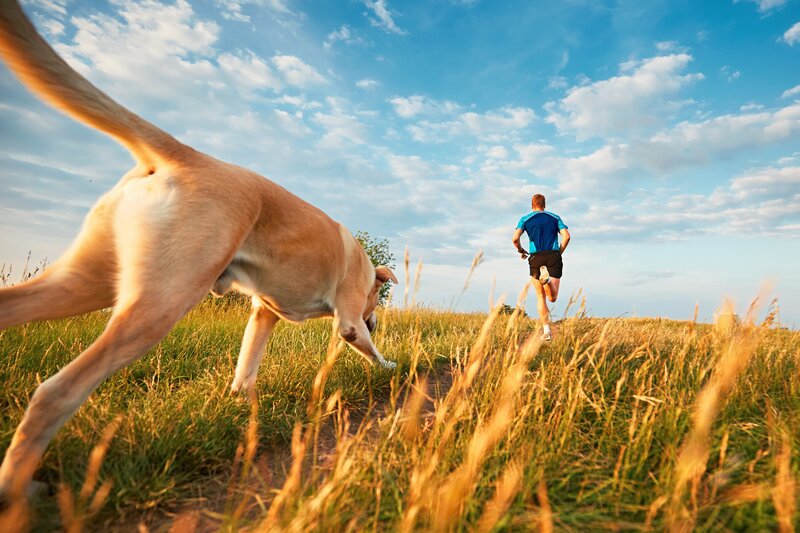
Here is the great news about how much exercise your dog requires - most dogs need roughly the same amount of exercise as you do. The CDC recommends that all humans get at least 30 minutes of moderate exercise daily. If you have a dog, they need at least that much - and more is almost always preferred.
And, like humans, different dogs have more energy to burn, which also affects how much exercise - and the type of exercise - are the best fit.
There are multiple benefits of getting enough exercise (for dogs and humans). They include:
However, there is one difference between dogs and humans; humans aren’t available in different breeds.
There is no arguing that different dog breeds require different levels of exercise. However, it’s also worth noting that a dog’s size doesn’t correlate to energy needs.
For example, while Greyhounds might be large and originally bred to be racing dogs, they're sprinters and not marathon runners. Therefore, they’re happy to lounge about in the apartment with only a short to medium walk each day. That’s very different from a working dog, such as a Husky or herding dog bred to go-go-go for hours at a time.
With that foundation in mind, here are six ways to ensure your dog gets enough daily exercise.
Do your homework and be honest with yourself about your lifestyle. Don’t get a dog with the idea that it will encourage you to walk or exercise every day. Instead, choose a dog that meets your current lifestyle reality. If that also means you’re encouraged to walk or exercise more - it’s a win-win for you both.
The flip side of that is don’t buy a toy poodle if you want a dog to accompany you on your weekly runs or marathon hikes. In that case, a working, sporting or herding dog is a much better fit! Dogs known for having high energy levels need an average of two hours a day to keep fit and not go stir-crazy.
Read books, research posts about choosing the right dog breed online, or speak to your vet or a local dog trainer to learn more about which breed is the best fit for your household, yard, family, and your current exercise routine.
Just like humans, puppies and juvenile dogs have far more energy than their adult versions. Even if you opt to get a breed that does just fine with a moderate walk each day, you should expect to put in more dog exercise time for the first year to three. In most cases, small dogs are full-grown and reach maturity in the first one to two years, while larger breeds take up to two or three years to move out of the puppy-like energy phase.
If there is more than one person in the household, and you notice the dog walks are tapering off, create a dog walking schedule and take turns. Dogs that don’t get exercise are far more likely to have separation anxiety or to participate in destructive behaviors to vent pent-up energy and frustration.
Make walking the dog part of the weekly family schedule. If you’re a parent, I assure you that taking the time to walk your dog with a child or with your children will provide opportunities for conversation and connection you wouldn’t have otherwise.
NOTE: You can also hire professional dog walkers to walk your dog for you on days your schedule doesn’t have room OR you could take them to doggy daycare twice a week.
Don’t have the time to take a walk every day? Consider visiting a local dog park in your area. Do a tour and find a favorite. In addition to socializing your dog with other dogs (just as important as socializing your dog with people and various environments), you have the opportunity to take a break for a bit as your dog plays, wrestles, chases, and romps around with other dogs.
In most cases, dogs that make it to the dog park a few times a week get far more opportunities for intense exercise levels than they have on the average walk. While it’s essential to keep an eye on your dog and engage with what’s happening (scuffles do take place from time to time), many people use dog park time to schedule a work phone call or catch up on emails or other tasks, optimizing the schedule space.
I’ve met very few dogs that don’t enjoy a good daily play session. And playing counts as exercise. That might look like 15 to 30 minutes of:
Have you ever seen a dog work its way through an agility course? If not, Click Here (skip to 2:17 if you don’t want to hear the announcers). While you shouldn’t feel pressured to compete in the Masters' Agility Competition at Westminster, you’ll be amazed at what just about any dog can learn - and love to do - with a basic backyard agility course.
Enrolling your dog in a group dog training class provides multiple benefits. First, you’ll be in touch with qualified dog trainers in your area and learn professional tips and tricks to teach your dog basic obedience cues along with some fun tricks. Second, your dog gets socialized with other dogs and people. Finally, the network of other dog-loving humans keeps you connected to the area's best dog parks and other dog-friendly places to exercise - as well as opportunities to schedule dog play dates.
Do you need an exercise outlet for your dog? Schedule an in-home consultation or group training session with Alternative Canine Training. We’ll provide professional and personalized recommendations about the best ways to ensure your dog gets the exercise they need. We can also refer you to the area’s best dog sitters, dog walkers, and doggy daycare providers - all of whom can be additional dog exercise resources.